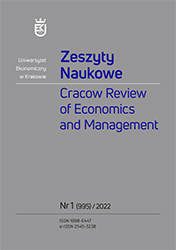Initial Assessment of the Impact of Coffee Bean Roasting Temperature on the Quality of the Product and Coffee Infusions
DOI:
https://doi.org/10.15678/ZNUEK.2022.0995.0105Keywords:
coffee, roasting process, quality determinants, sensory qualityAbstract
Objective: The roasting process of green coffee beans has a significant impact on the properties of the finished product, which may be critical to its acceptance by consumers. In that light, the aim of this study was to evaluate the influence of the conditions of this process on the sensory and physicochemical determinants that shape the quality of coffee.
Research Design & Methods: The research material consisted of Arabica coffee samples with varying degrees of roasting. The water and caffeine contents were measured, as was the sensory quality before and after the infusion was made.
Findings: The degree of roasting of the coffee beans did not have an impact on the differences in the water content in the finished product. Moreover, the caffeine content was at the level typical for Arabica coffees. The coffees tested met the requirements of the standards in terms of organoleptic parameters. After preparing the infusion, all of the coffees were of high sensory quality. Nevertheless, the samples with the highest degree of roasting returned statistically significantly worse performance for indicators on the total sensory quality index. This was due to their significantly lower taste and color ratings.
Implications / Recommendations: The parameters chosen for the coffee roasting process influenced its sensory features. The coffee infusion with a very dark roast degree was assessed to be significantly worse in terms of color and taste than the other samples. The parameters of the roasting process of coffee beans may therefore significantly affect the consumer acceptance of drinks made from them.
Contribution: Contributes to the knowledge on the optimisation of product quality from the consumer’s point of view.
Downloads
References
Barbosa M.D.G., Scholz M.B.S., Kitzberger C.S.G., Benassi M.D. (2019), Correlation between the Composition of Green Arabica Coffee Beans and the Sensory Quality of Coffee Brews, „Food Chemistry”, vol. 292, https://doi.org/10.1016/j.foodchem.2019.04.072. DOI: https://doi.org/10.1016/j.foodchem.2019.04.072
Cagliani L.R., Pellegrino G., Giugno G., Consonni R. (2013), Quantification of Coffea Arabica and Coffea Canephora var. Robusta in Roasted and Ground Coffee Blends, „Talanta”, vol. 106, https://doi.org/10.1016/j.talanta.2012.12.003. DOI: https://doi.org/10.1016/j.talanta.2012.12.003
Caporaso N., Whitworth M.B., Grebby S., Fisk I.D. (2018a), Non-destructive Analysis of Sucrose, Caffeine and Trigonelline on Single Green Coffee Beans by Hyperspectral Imaging, „Food Research International”, vol. 106, https://doi.org/10.1016/j.foodres.2017.12.031. DOI: https://doi.org/10.1016/j.foodres.2017.12.031
Caporaso N., Whitworth M.B., Grebby S., Fisk I.D. (2018b), Rapid Prediction of Single Green Coffee Bean Moisture and Lipid Content by Hyperspectral Imaging, „Journal of Food Engineering”, vol. 227, https://doi.org/10.1016/j.jfoodeng.2018.01.009. DOI: https://doi.org/10.1016/j.jfoodeng.2018.01.009
Cavaco Bicho N., Leitão A.E., Cochicho Ramalho J., de Alvarenga N.B., Cebola Lidon F. (2013), Impact of Roasting Time on the Sensory Profile of Arabica and Robusta Coffee, „Ecology of Food and Nutrition”, vol. 52(2), https://doi.org/10.1080/03670244.2012.706061. DOI: https://doi.org/10.1080/03670244.2012.706061
Chabert P. (2013), Cenne reakcje. Proces palenia zielonej kawy, „Przegląd Gastronomiczny”, vol. 67(4).
Cho J.-S., Bae H.-J., Cho B.-K., Moon K.-D. (2017), Qualitative Properties of Roasting Defect Beans and Development of Its Classification Methods by Hyperspectral Imaging Technology, „Food Chemistry”, vol. 220, https://doi.org/10.1016/j.foodchem.2016.09.189. DOI: https://doi.org/10.1016/j.foodchem.2016.09.189
Farah A., De Paulis T., Moreira D.P., Trugo L.C., Martin P.R. (2006), Chlorogenic Acids and Lactones in Regular and Water-decaffeinated Arabica Coffees, „Journal of Agricultural and Food Chemistry”, vol. 54(2), https://doi.org/10.1021/jf0518305. DOI: https://doi.org/10.1021/jf0518305
Fox G.P., Wu A., Liang Y.R., Force L. (2013), Variation in Caffeine Concentration in Single Coffee Beans, „Journal of Agricultural and Food Chemistry”, vol. 61(45), https://doi.org/10.1021/jf4011388. DOI: https://doi.org/10.1021/jf4011388
Jeon J.-S., Kim H.-T., Jeong I.-H., Hong S.-R., Oh M.-S., Park K.-H., Shim J.-H., Abd El-Aty A.M. (2017), Determination of Chlorogenic Acids and Caffeine in Homemade Brewed Coffee Prepared under Various Conditions, „Journal of Chromatography B-Analytical Technologies in the Biomedical and Life Sciences”, vol. 1064, https://doi.org/10.1016/j.jchromb.2017.08.041. DOI: https://doi.org/10.1016/j.jchromb.2017.08.041
Kitzberger C.S.G., Scholz M.B.D., Pereira L.F.P., Benassi M.D. (2013), Chemical Composition of Traditional and Modern Arabica Coffee Cultivars, „Pesquisa Agropecuaria Brasileira”, vol. 48(11), https://doi.org/10.1590/S0100-204X2013001100011. DOI: https://doi.org/10.1590/S0100-204X2013001100011
Monteiro P.I., Santos J.S., Rodionova O.Y., Pomerantsev A., Chaves E.S., Rosso N.D., Granato D. (2019), Chemometric Authentication of Brazilian Coffees Based on Chemical Profiling, „Journal of Food Science”, vol. 84(11), https://doi.org/10.1111/1750-3841.14815. DOI: https://doi.org/10.1111/1750-3841.14815
Nebesny E., Budryn G. (2006), Evaluation of Sensory Attributes of Coffee Brews from Robusta Coffee Roasted under Different Conditions, „European Food Research and Technology”, vol. 224(2), https://doi.org/10.1007/s00217-006-0308-y. DOI: https://doi.org/10.1007/s00217-006-0308-y
Olech W., Wieczorek M. (2003), Zastosowanie metod statystyki w doświadczalnictwie zootechnicznym, Wydawnictwo SGGW, Warszawa.
PN-A-76100:2009, Kawa palona – Wymagania i metody badań, PKN, Warszawa.
PN-ISO 6668:1998, Kawa zielona – Przygotowanie próbek do analizy sensorycznej, PKN, Warszawa.
PN-ISO 8586-1:1996, Analiza sensoryczna – Ogólne wytyczne wyboru, szkolenia i monitorowania oceniających – Wybrani oceniający, PKN, Warszawa.
PN-ISO 10095:1997, Kawa – Oznaczanie zawartości kofeiny – Metoda wykorzystująca wysoko sprawną chromatografię cieczową, PKN, Warszawa.
Rim K.-T., Kim S.-J. (2019), A Toxicogenomics Study of Two Chemicals in Coffee Roasting Process, „Molecular & Cellular Toxicology”, vol. 16(1), https://doi.org/10.1007/s13273-019-00055-8. DOI: https://doi.org/10.1007/s13273-019-00055-8
Scholz M.B.S., Kitzberger C.S.G., Pagiatto N.F., Pereira L.F.P., Davrieux F., Pot D., Charmetant P., Leroy T. (2016), Chemical Composition in Wild Ethiopian Arabica Coffee Accessions, „Euphytica”, vol. 209(2), https://doi.org/10.1007/s10681-016-1653-y. DOI: https://doi.org/10.1007/s10681-016-1653-y
Yergenson N., Aston D.E. (2019), Monitoring Coffee Roasting Cracks and Predicting with in Situ Near-infrared Spectroscopy, „Journal of Food Process Engineering”, vol. 43(2), https://doi.org/10.1111/jfpe.13305. DOI: https://doi.org/10.1111/jfpe.13305
Zawadzka-Ben Dor R. (2008), Zapach świeżo mielonej kawy, „Przegląd Piekarski i Cukierniczy”, nr 9.
Downloads
Published
Issue
Section
License
Copyright (c) 2022 Zeszyty Naukowe Uniwersytetu Ekonomicznego w Krakowie / Cracow Review of Economics and Management

This work is licensed under a Creative Commons Attribution 4.0 International License.

